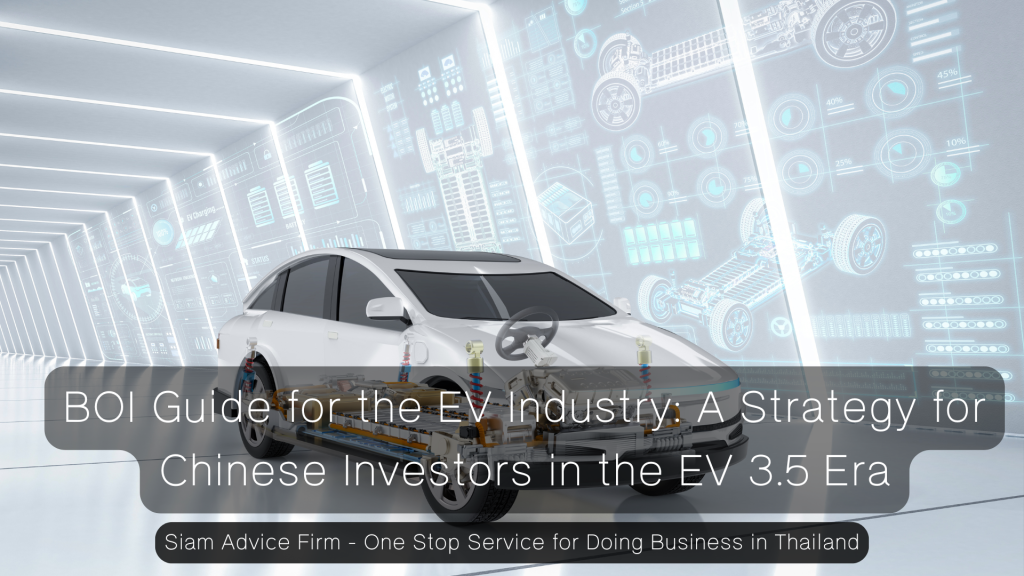
With Chinese electric vehicle brands capturing over 70-80% of the market share, Thailand has undeniably become the most important “second home” for China’s rapidly expanding EV industry. This explosive growth, fueled by strong consumer demand and government support, paints a picture of a modern-day gold rush.
But behind this incredible success story lies a complex and challenging reality: a fierce price war is eroding profit margins, planned production capacity vastly outstrips current domestic demand, and government policies are continually evolving. Entering this market or expanding operations with a generic Board of Investment (BOI) application, without a strategy tailored to the unique pressures of the EV sector, can be a major misstep.
This guide is designed specifically for Chinese EV entrepreneurs and manufacturers. We will cut through the complexity of the latest EV 3.5 policy and outline a strategic BOI approach that will enable you not just to enter the market, but to compete and grow sustainably for years to come.
Understanding Thailand’s EV 3.5 Policy
The EV 3.5 program, running from 2024 to 2027, is the Thai government’s primary tool for accelerating EV adoption and establishing the nation as a regional production hub. For investors, its key components include consumer subsidies to drive sales, significant reductions on import duties for completely built-up (CBU) vehicles, and a lowered excise tax from 8% to 2%.
However, these attractive incentives come with a critical trade-off that forms the core of any investment strategy: the local production offset requirement. In simple terms, for every one CBU you import and sell in 2024-2025, you are obligated to produce two units locally by 2026, rising to three units by 2027. This legally binding commitment directly impacts your investment timeline, factory scale, and overall business plan.
Maximizing BOI Benefits for the Entire EV Supply Chain
A common misconception is that BOI benefits are only for large-scale vehicle assembly plants. In reality, the BOI promotes the entire EV ecosystem, allowing for a vertically integrated and highly incentivized investment strategy. Key promoted activities include:
- Electric Vehicle Assembly: This covers Battery Electric Vehicles (BEVs), Plug-in Hybrid Vehicles (PHEVs), and even electric buses and trucks.
- Battery Production: This includes manufacturing cells, modules, and packs, as well as establishing battery swapping stations.
- Key Component Manufacturing: The BOI specifically promotes the production of at least 17 critical EV parts, including the traction motor, Battery Management System (BMS), DC/DC converter, and on-board charger.
- Charging Stations: Incentives are available for producing and deploying both AC and DC charging stations across the country.
Expert Insight: A single company can apply for promotion across multiple categories simultaneously. For instance, an investor can structure a single project that includes a vehicle assembly line, a battery pack plant, and key component manufacturing, layering the benefits from each category to create a powerful, cost-competitive, and fully integrated operation.
The “Gold Rush vs. Reality”: A Strategic Analysis
The Thai EV market presents a classic case of immense opportunity balanced by significant challenges. A successful strategy must acknowledge both sides of this coin.
The Opportunity (The Gold Rush): The appeal is obvious. Chinese brands enjoy massive market dominance, and the government’s EV 3.5 policy provides direct support to stimulate sales and lower import costs, creating a fertile ground for investment.
The Challenge (The Reality): Investors must honestly confront the market’s underlying pressures. The insights from market analysis are clear:
- Intense Price War: With nearly 20 Chinese EV brands competing in Thailand, aggressive price cuts have become the norm, severely pressuring profit margins for all players.
- Potential Oversupply: The combined planned production capacity of new factories far exceeds current and projected domestic sales, raising serious concerns about a future supply glut.
The Strategic Solution: Your BOI plan is not just a regulatory application; it is your most powerful tool for addressing these specific challenges. A smart strategy uses the BOI framework to:
- Lower Production Costs to Win the Price War: By leveraging the full suite of CIT exemptions and import duty waivers on machinery and components, you can significantly lower your cost base. This provides the financial cushion needed to compete on price while protecting your margins.
- Establish Thailand as an Export Hub: The most effective way to mitigate the risk of domestic oversupply is to use Thailand as a production base to export to the wider ASEAN market and beyond. The BOI framework fully supports this, offering duty exemptions on raw materials imported for export production. This transforms the oversupply challenge into a regional growth opportunity.
Conclusion
Success in Thailand’s EV market is no longer measured by simply gaining entry; it is measured by the ability to compete and win in a crowded, hyper-competitive field. Your BOI application is not a piece of administrative paperwork—it is the cornerstone of your competitive strategy.
A well-structured plan must be deeply integrated with your business model, specifically designed to counter the unique price and supply pressures of the Thai EV industry. This strategic alignment is what separates the market leaders from the rest.
Ready to see the entire process from start to finish? Read our Complete Guide to BOI Promotion.
Is your EV project structured to win in this highly competitive market? Contact our EV industry expert team for a strategic review.